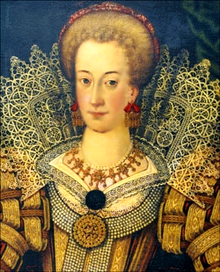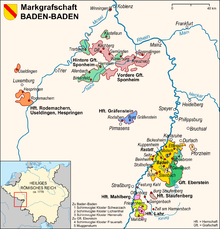Cecilia Wasa
Cäcilie Wasa (born November 6, 1540 in Stockholm , † January 27, 1627 in Brussels ) was Princess of Sweden and Margravine of Baden-Rodemachern. She was a daughter of Gustav I. Wasa , King of Sweden, and Margareta Eriksdotter Leijonhufvud .
Life
Cäcilie was only 11 years old when her mother, Gustav Wasa's second wife, died. There were latent tensions in the Wasa family as the eldest son from Gustav Wasa's first marriage, Erik , felt disadvantaged compared to his younger half-brother, Johann . The easy-going Erik felt oppressed by his father and set out to offend him.
Cäcilie was the most beautiful of the daughters of Gustav I and drew attention to herself in the so-called "Vadstenalärm" in 1559 when she was surprised under compromising circumstances with Count Johann von Ostfriesland by agents of her eldest brother Erik , just as Edzard , the lover's brother, Katharina , the king's eldest daughter, had married and spent the night with the wedding suite at Vadstena Castle at Christmas 1559 . Erik did not care about the reputation and honor of his half-sister and the family, but made the affair officially known by the public imprisonment of Johann von Ostfriesland, which displeased his father, who would have preferred the matter to be handled discreetly.
Despite the sensation that this affair caused in the aristocratic world of Europe, members of the high nobility continued to campaign for Cecilia. In 1561 he was engaged to the Polish ambassador, Count Johann von Tenczin, but was broken off again on the intervention of the Polish king. Tenczin died in 1564. In the same year Cäcilie married Margrave Christoph II von Baden-Rodemachern , who served as a colonel in the Swedish army.
Immediately after their wedding, Cäcilie and Christoph were suspected of colluding with Duke Johann , the half-brother of King Erik, who was imprisoned at Gripsholm Castle , as Cäcilie was campaigning for her brother to be released. The young couple had to leave Sweden and stayed for about a year in London , where Cäcilie gave birth to Eduard Fortunat - Queen Elizabeth I was godmother.
In the debt tower
Since Cäcilie got so deeply entangled in debt through her extravagance that she and Christoph - who wanted to kidnap her from London from her creditors in 1566 - were temporarily brought into custody, the intervention of the English queen and the guarantee of German merchants were required to get out. They moved to their margraviate Baden-Rodemachern.
Back in Sweden
After the Dutch struggle for independence had started in 1568 and because the Luxembourg possessions of the House of Baden (Baden-Rodemachern) also suffered from the Spanish troops of the Duke of Alba , Cäcilie and Christoph returned to Sweden in the summer of 1571. Christoph traveled back to Germany alone at the beginning of 1572 to devote himself to the government of his margraviate and did not meet Cäcilie until his death in 1575. Cäcilie continued the fight for her dowry , which damaged the relationship with her brother Johann, who was now the Swedish king.
As Countess of Arboga, Cäcilia is said to have maintained a pirate fleet.
The convert
After the death of her husband Christoph II von Baden-Rodemachern in 1575, Cäcilie converted to the Catholic faith. The conversion is attributed on the one hand to the influence of her sister-in-law Katharina Jagiellonica , the wife of her brother Johann . On the other hand, it is believed that she wanted to save the areas in Lorraine, which were partly occupied by Catholic, Spanish troops, for her children.
Cäcilie did not accept the guardianship of Margrave Karl II of Baden-Durlach and Bishop Marquard of Speyer , as stated in Christoph's will, and tried to gain power in Rodemachern herself or through her brother. The conversion to Catholicism probably also pursued the secondary political aim of gaining support against the Protestant relatives of the House of Baden-Durlach .
This policy was also evident in her son Eduard Fortunat and led to success with her grandson Wilhelm in 1622.
Cäcilie's change of religion established the deep dispute between the lines of the House of Baden.
Marriage and offspring
Cäcilie Wasa married Margrave Christoph II von Baden-Rodemachern (1537–1575) on November 11, 1564 and had six children with him:
- Eduard Fortunat (born September 17, 1565 - † June 18, 1600)
- Christoph Gustav (born August 13, 1566 - † January 18, 1609)
- Philipp (August 15, 1567 - November 6, 1620)
- Karl (7 March 1569; † 1590)
- Bernhard (December 1570 - February 1571)
- Johann Karl (* 1572; † January 29, 1599), he was a Maltese
Cäcilie is said to have had a daughter, Caritas, in 1579 from an illegitimate relationship with the Spanish diplomat Francisco de Eraso.
literature
- Johann Christian Sachs : Introduction to the history of the Marggravschaft and the Marggravial old princely house of Baden . Third part. Lotter, Carlsruhe 1769, p. 267–282 ( limited preview in Google Book search).
- Karl Brunner: Cäcilia Wasa, Margravine of Baden Rodemachern . In: Journal for the history of the Upper Rhine , Volume 54 (NF 15, 1900), pp. 15 ff., Internet Archive
- Historical novel
- L. Countess of Robiano: Gustav Wasa . Volume 2, Jena 1868, pp. 289–305 ( limited preview in Google book search)
Web links
References and comments
- ↑ JW von Archenholtz: History of Gustavs Wasa, King of Sweden . 2nd volume. Tübingen 1801, pp. 279-282
- ↑ Celsio, Olao: History of King Gustav the First . tape 2 . Copenhagen / Leipzig 1753, p. 431-432 .
- ↑ Brunner, p. 20
- ↑ The couple first traveled from Scheden via Livonia and Estonia to Rodemachern , where Christoph set up his residence. Cäcilie did not find the provincial harvesters intoxicating and so they traveled together to London as early as 1565. Christoph returned to Rodemachern at the end of 1565, while the pregnant Cecilia stayed in London with financial support from the Queen.
- ↑ Friedrich Bülau (Ed.): Secret stories and enigmatic people . Volume 11, Leipzig 1864, p. 145
- ↑ Brunner, p. 22
- ^ The dowry of 100,000 was paid according to Sachs, p. 277, which Brunner denies, p. 20.
- ↑ arboga.se ( Memento of the original from April 7, 2016 in the Internet Archive ) Info: The archive link was inserted automatically and has not yet been checked. Please check the original and archive link according to the instructions and then remove this notice.
- ↑ see Cäcilia ( Memento of the original from January 15, 2012 in the Internet Archive ) Info: The archive link was inserted automatically and has not yet been checked. Please check the original and archive link according to the instructions and then remove this notice. on The Ambassadors of St. Peter Guilde (English)
| personal data | |
|---|---|
| SURNAME | Cecilia Wasa |
| ALTERNATIVE NAMES | Cecilia Vasa (Swedish); Cecilia of Sweden; Cäcilie von Baden-Rodemachern; Cäcilie Wasa of Sweden |
| BRIEF DESCRIPTION | Princess of Sweden, Margravine of Baden |
| DATE OF BIRTH | November 6, 1540 |
| PLACE OF BIRTH | Stockholm |
| DATE OF DEATH | January 27, 1627 |
| Place of death | Brussels |

